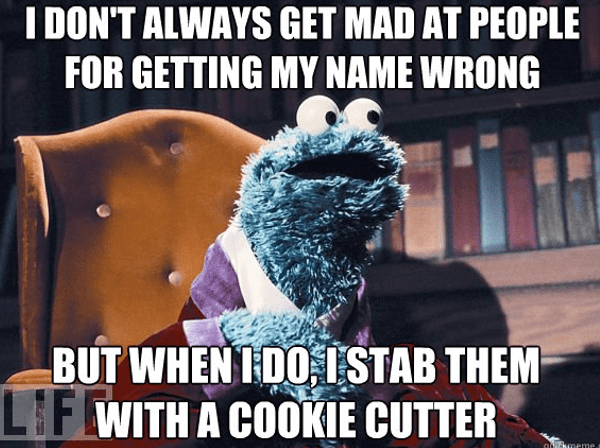
Everything I learned about saying “thank you” I learned from:
According to Burk’s research from Donor-Centered Fundraising, more than 80% of thank you letters start with “Thank you for your generous gift of…” or “On behalf of the Board of Directors, thank you for your generous gift of…”
Y A W N
- Want to stand out?
- Want your donor to actually read your letter?
- Want your donor to feel good about the decision they made to invest in you?
- Want your donor to feel warm and fuzzy inside?
- Want your donor to say “Aw, that’s SO nice!”
- Want your donor to feel the opposite of bored?
BEGIN WITH SOMETHING DIFFERENT.
Don’t even say “thank you” in your first sentence. And don’t mention a dollar amount. Instead, let the donor know immediately what they accomplished!
- Because you cared, Jimmy will go to bed with a fully tummy tonight.
- Your gift just rescued a puppy.
- Because of your compassion, Sheila knows for the first time in months she is not alone.
INCLUDE BODY COPY THAT’S DIFFERENT.
After the opening sentence, a preponderance of thank you letters continue with data about numbers served by the charity, total dollars raised by the charity, and work still needing to be done. Don’t do this. A thank you is a thank you. Not a sales piece or a lament. Alas, the body copy of most thank you letters is often filled with little more than jargon, platitudes and ego-centric statements of what the charity is accomplishing. Oh, dear. You want to convey the donor’s awesomeness, not your own.
PUT YOUR DONOR AT THE CENTER.
It’s about them, not you.
Surely by now you’ve learned the simplest editing trick of all: Cross out every instance of “I,” “we,” “our,” and “[name of charity].” Your charity didn’t accomplish the outcomes; your donor did! You’re not the hero of the story; your donor is! Without your donor’s investment, none of the outcomes of which you speak would be possible. And, speaking of outcomes…
Surely by now you’ve learned your letter should be about specific accomplishments your donor made possible? Not about the fact you’re proud to continue being a beacon of hope… or bastion of justice… or world class arts venue. And speaking of specific accomplishments…
Surely by now you’ve learned to tie your thank you letter to your campaign, so the donor is reminded of why they gave and reassured their gift will be used as they intended?
Then why aren’t you doing these things?
Donor-centered thank you letters are not just a nicety
They’re the critical first step to getting the next gift.
And donors tell us this again and again.
Since Penelope Burk first began conducting her research, over two decades ago, donors have consistently pointed to the things they most want from nonprofits to whom they make gifts. It’s just three simple things:
-
- Prompt thank you.
- Personal thank you.
- Powerful thank you that demonstrates the impact of their gift as per their intent.
That’s it!
Not engraved plates. Their name in lights. Gala invites. Newsletters or annual reports.
Just timely, genuine, heartfelt, meaningful gratitude.
PROMPT means within 48 hours
Donors need reassurance their gift was needed, and that they made a wise investment. If they don’t hear back from you right away, they’ll begin to think their gift didn’t much matter to you.
Plus, recency is the most important predictor of likelihood to give. If your donor is stuck in processing mode for a month or two after giving, you’ll miss out on their most-likely-to-give-again period – a time when you could have received a second gift.
PERSONAL means showing them you know them
Donors are telling us: “Write the thank you to me.”
They’re saying they aren’t just a generic “friend” or “donor.” They are a singular human being,
They’re saying they want you to speak to them directly, as someone special who just acted on their personal passions and cherished values.
Take the time to enter personal salutations into your database, and use them.
POWERFUL means connecting with what your donor values
And you know what they value, because they told you with their gift!
- If they gave specifically to support your cat rescue program, don’t send them a letter that’s about your entire animal shelter.
- If they gave specifically to your after-school snack program, don’t send them a letter about the 78,000 meals you served to children, adults and elderly last year.
- If they gave specifically to support your rural veterans’ legal aid clinics, don’t send them a letter about the 185,000 people you helped statewide with a range of legal problems.
Of course, I would recommend you go beyond the initial thank you and repeat your prompt, personal and powerful gratitude multiple times throughout the year before you make another ask. Thank, thank, thank, ask. Thank, thank, thank, ask. But that’s the subject for another article. Let’s get back to…
How to craft a meaningful, memorable thank you letter
Your goal is to make donors feel good so they want to give again.
Your goal is not to check “donor acknowledgement sent” off your list.
There is a HUGE difference between thank you’s that fulfill the requirement of acknowledging gifts and thank you’s that inspire donor loyalty.
The fact that you sent me a ‘contemporaneous receipt’ (IRS language) for my tax records at the end of the calendar year may satisfy legal requirements. But it won’t inspire loyalty. By the time I receive your December receipt for the gift I made in September, I’ve all but forgotten about you.
And if the receipt doesn’t remind me of the intended purpose of my gift, and include powerful language about how much my investment meant to you, I may just end up scratching my head and wondering when and why I made this donation.
20 Things Donors Say Make Thank You Letters Superior
This comes directly from Penelope Burk’s research:
-
The letter is a real letter, not a pre-printed card.
-
It is personally addressed.
-
It has a personal salutation (no “dear donor” or “dear friend”).
-
It is personally signed.
-
It is personally signed by someone from the highest ranks of the organization
-
It makes specific reference to the intended use of funds.
-
It indicates approximately when the donor will receive an update on the program being funded.
-
It includes the name and phone number of a staff person whom the donor can contact at any time or an invitation to contact the writer directly.
-
It does not ask for another gift.
-
It does not ask the donor to do anything (like complete an enclosed survey, for example.)
-
It acknowledges the donor’s past giving, where applicable.
-
It contains no spelling or grammatical errors.
-
It has an overall “can do”, positive tone as opposed to a hand wringing one.
-
It communicates the excitement, gratitude and inner warmth of the writer.
-
It grabs the reader’s attention in the opening sentence.
-
It speaks directly to the donor.
-
It does not continue to “sell”.
-
It is concise – no more than two short paragraphs long.
-
It is received by the donor promptly.
-
Plus, in some circumstances, the letter is handwritten.
Thank you is an opportunity to connect meaningfully
In a Burk Donor Survey, 40% of respondents said they had received at least one thank you letter in recent memory they would describe as exceptional. Its “warm, personal tone making the letter feel like it was written just for me” was cited most often.
- 45% of donors said it was an outstanding thank you letter that inspired them to give again.
- 23% said they gave more generously because of the quality of the acknowledgement they received.
If your modus operandi is calculating how little you can get away with when it comes to donor acknowledgements, you’re missing the boat. You’ll still have the one gift, but you’re unlikely to get another.
Want to build donor loyalty over time?

With the absolute best ways to keep donors for life
Grab the Attitude of Gratitude Donor Guide + Creative Ways to Thank Your Donors. It includes everything I’ve learned over the years, all tucked it into one handy non-nonsense Guide on the practice of gratitude.
106 full pages, with lots of ready-to-use samples and templates. And it includes Creative Ways to Thank Your Donors— with 72 ideas for you to steal!
If you’re not happy with it for any reason, all Clairification products come with a no-questions-asked, 30-day, 100% refund guarantee.
#Donors #Lament #Didnt #Properly










